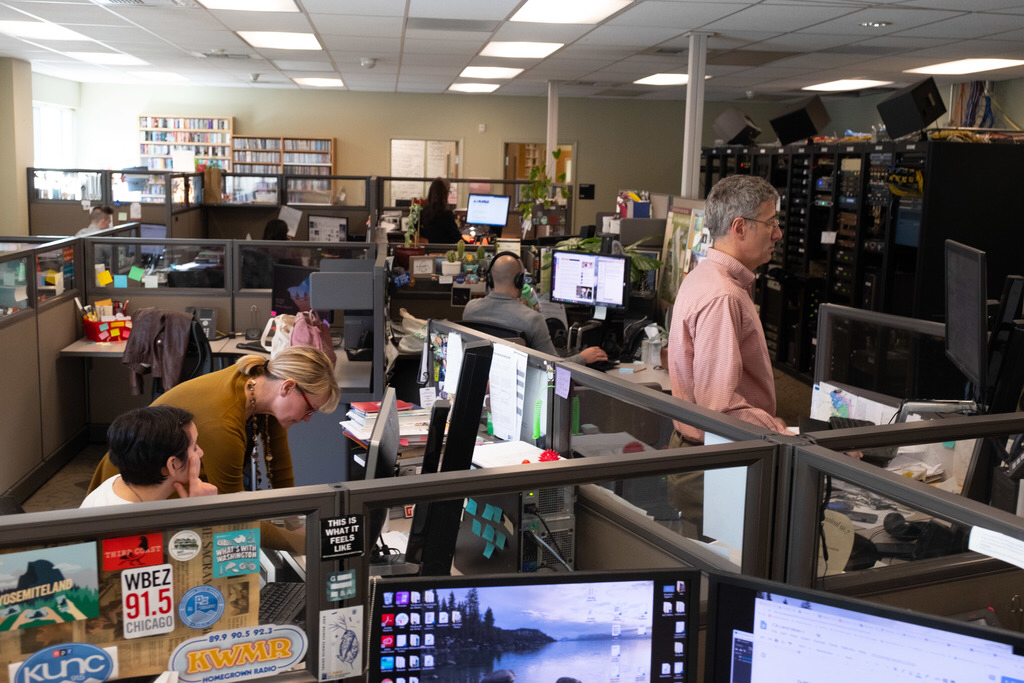
In the ongoing discussion of how consumers use broadcast radio amidst a growing number of options and choices, news and information isn’t usually an integral part of the conversation.
That’s because commercial radio stations – especially on FM – are primarily focused on music formats. And then when broadcasters consider the new media landscape, they typically think of Spotify, Pandora, and SiriusXM. Or they’re heavily focused on podcasts
News and talk radio programming? Not so much.
Part of the reason may revolve around the reality that much of this content has been relegated to the AM band. Except in public radio, that is, where news and information is alive and well. Not only does it usually live on FM stations, but public radio stations increasingly take their news and information very seriously.
So does their audience. Our Public Radio Techsurveys have become the annual yardstick for measuring trends in this radio space. A key question we ask respondents is where they frequently discover news and information stories. Their loyalty to public radio is impressive – their top source of news discovery, over newspapers, television, and websites. Only a small percentage look to commercial radio stations for this content. Keep in mind, these are core public radio listeners to begin with.
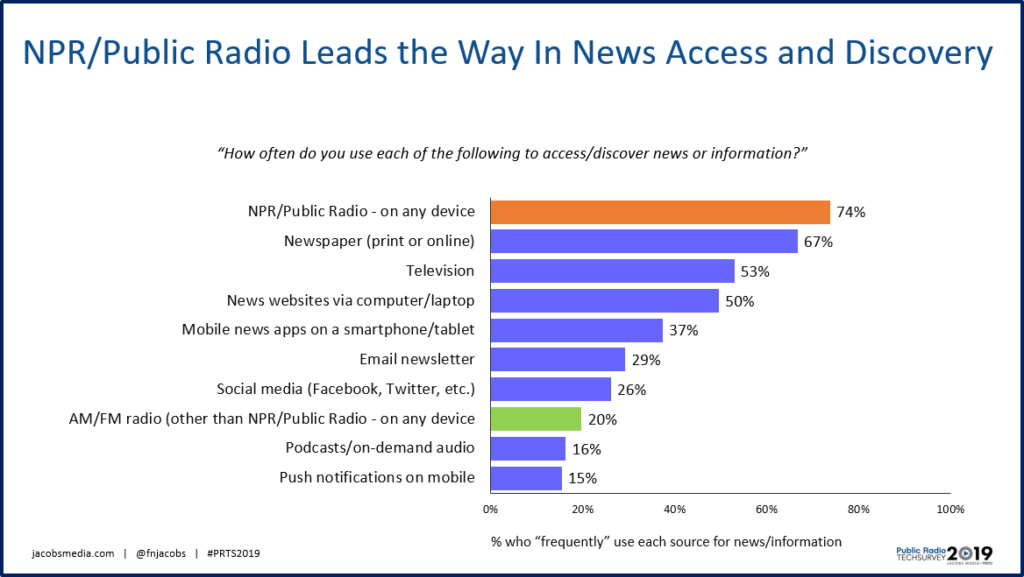
So, it was not surprising to read a story last week in the radio trades covering a new effort by NPR and a group of California-based public radio stations to band together to produce news content. On the one hand, it was affirmation that a group of disparate public radio franchises in the most populated state in the union can actually collaborate with one another to achieve lofty content creation goals. And on the other, it was an indicator that public radio is aggressively going after the top slot for radio news coverage.
Led by Bay Area radio success story, KQED, the consortium includes the state’s public radio heavy hitters, including KPCC (LA/Pasadena, whose newsroom is pictured below left), KCRW (LA/Santa Monica), KPBS (San Diego), and CapRadio (Sacramento) whose newsroom is pictured at the top of this post.
And, of course, NPR is at the core of this news and information initiative.
KQED’s Chief Content Officer, Holly Kernan, told me, “Public media is one of the solutions to the crisis in local journalism. This collaboration is a way for us to increase our impact and public service journalism. We are just getting started.”
The California news project isn’t just about pooling resources from these leading public radio stations in major California metros. It will also draw in reporting from smaller outlets across the state in an effort to serve what are referred to as “news deserts” – less populated areas that receive little-to-no radio news coverage.
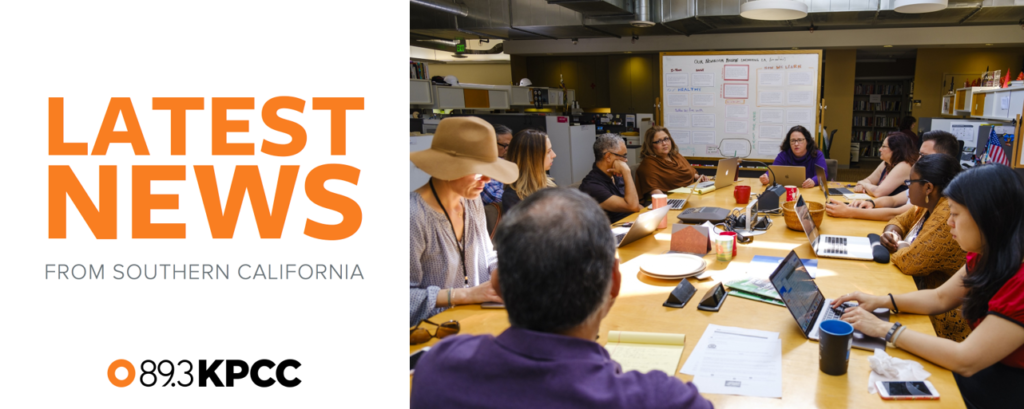
In much the same way joint efforts and partnerships are highly challenging to pull off in the commercial radio sector, these public radio stations are generally operated by academic institutions that are rarely on the same page. But an effort of this magnitude requires cooperation, vision, and a sense of collective purpose.
And this new consortium in California is not a one-off. These type of collaborations exist in other regions and states, and will undoubtedly become more common in the coming months years. In the Lone Star State, it’s the “Texas Newsroom,” a similar amalgamation of state-wide stations working once again with NPR. And similar conversations are happening in other states where pooled coverage works for all parties – including underwriters and listeners.
The “Texas Newsroom” was created last year, and as its senior editor Rachel Osier Lindley explains, “We have several strong newsrooms in Texas covering their local communities. There are also trends and connections between our communities that have broader, statewide implications. By collaborating and working together, we can tap the collective reporting might of our stations and create deeper, more compelling journalism for Texans.”
And while this hyper-news activity happening in the public radio sector, “all news” (or even news in the drives) is another format all but being abandoned by commercial radio in nearly all of the biggest markets across the country. And many of the remaining stations left in the game either program conservative talk or in the biggest markets, the utilitarian all-news format, that has become more about filling out the “news wheel” than it is doing journalism.
Beyond those exceptions, radio news on commercial radio has been abdicated by ownership because of its expense and the necessary long-term commitments needed to keep this station vibrant and healthy. Not in this economy.
At commercial radio conferences, it’s almost always about TALK – not NEWS. Radio has “boot camps” and entire conventions devoted to cult of personality talk hosts, but there’s apparently no room left in anyone’s agenda for radio journalism.
While syndicated personality shows proliferate on both AM and FM radio largely because they’re easy, cost-effective, and often successful in local markets, the industry has failed in previous efforts to provide a 24/7 all-news service stations in markets like Spokane, Savannah, and Syracuse where radio news – aside from public radio – has steadily diminished.
In public radio, these are known as “news deserts,” and pooled regional coverage and other efforts like the hubs in Texas and California are designed to provide service to smaller communities.
Since 2000, public radio news has only grown in stature, fueled by major news cycles where consumers have been searching with strong, objective, and dependable content on their car radios.
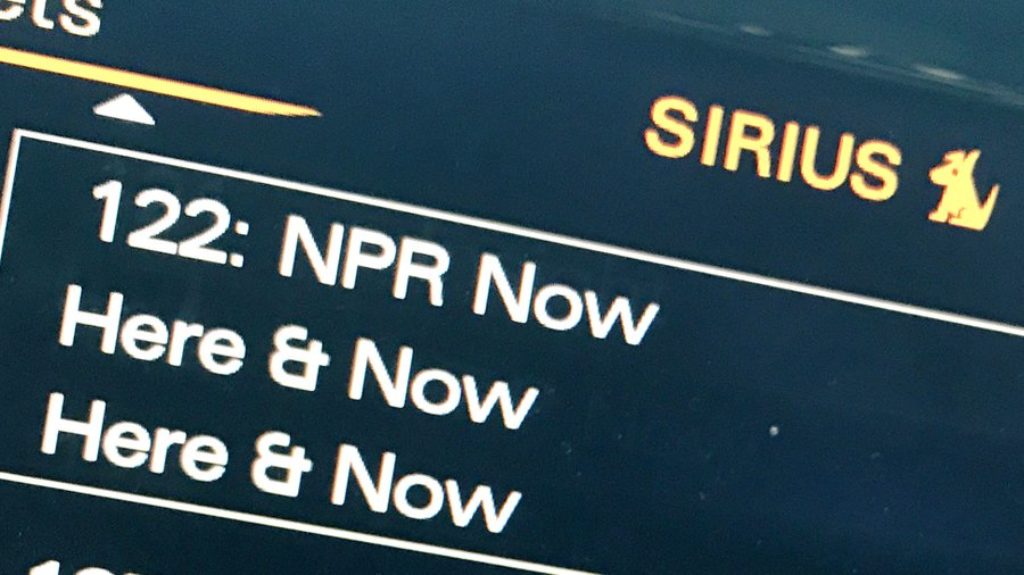 And then there’s SiriusXM.
And then there’s SiriusXM.
Since its beginnings, satellite radio has provided competition for spoken word commercial radio programming in the dashboard, but NPR was a step ahead of that trend.
They collaborated with Sirius more than 15 years ago on a channel that still exists today – “NPR Now.” Of course, we don’t know the “ratings” of the channel among the other options in the SiriusXM family, but research we’ve seen indicates it’s a popular channel for sat-rad subscribers.
Since the advent of “NPR Now,” there’s been increasing public radio presence and news/talk programming up and down the SiriusXM “dial.” Their team knows full well this type of content has been disappearing on the AM/FM bands these past couple decades, especially in medium and smaller markets.
An odd advantage public radio has enjoyed over its commercial radio brothers and sisters is that for decades, its numbers didn’t even show up in Arbitron rating books. For those of you who’ve worked in radio for more than a hot minute, conversations about public radio stations and programming have been nonexistent at conventions and conferences frequented by commercial radio pros. Public radio has always been shrugged off as an alien medium with no direct relationship to the activities of the biggest radio companies.
Since the advent of PPM, however, all that’s changed. Now, a look at 6+ numbers or those coveted 25-54 adult rankers often reveals a public radio station at or near the top of the heap in markets like San Francisco, Austin, D.C., Seattle, and so many other population and revenue centers.
The news cycle has aided and abetted these efforts, especially since Donald Trump took that slow escalator ride in Trump Tower back in 2015,  officially entering a political landscape he’s dominated ever since.
officially entering a political landscape he’s dominated ever since.
There’s been much talk these past several weeks about the impact of holiday music on the ratings. But few have mentioned the impeachment trial that dominated the American media scene throughout January, and well into this month.
Thanks to NPR, many public radio stations carried wall-to-wall coverage of this event. And while sacrifices were made in terms of covering underwriting announcement avails and other programming, the ratings results coming out over the next several weeks will most definitely confirm the wisdom of this commitment to carrying this event on public radio stations across America.
And now, we segue into the primaries, and before we know it, the election. In public radio circles, the phenomenon is known as “The Trump Bump.” And for the most part, it’s in its fourth year with no slowdown in sight. But media operations have to have their people, their facilities and equipment, their budgets, and their commitments in place if the benefits are to be reaped.
It is fascinating that on cable and network television, the competition between news services and networks is careening along at a breakneck pace. Prime time anchors have been providing on-the-scene anchoring and reporting over the weekends, in the morning hours, and at other odd times in order to take advantage of these news-filled times, when conversations at Starbucks, the lunchroom, and over Canasta have been dominated by the political discourse.
Last week alone on successive days, it was the Iowa Caucuses (and their subsequent blow-up, the State of the Union speech, the impeachment acquittal, and the White House firings. Not to mention the coronavirus and other stories that made up a routinely crazy week.
None of that is likely to diminish as we head into the November elections, and news outlets prepared for the action stand the best chance of reaping the benefits – ratings, revenue, and reputation.
In the world of news, that “last R” – reputation – is a value that must be earned. Every news outlet owns perceptions – the image for breaking news, analysis, objectivity, left wing, right wing – you name it. Consumers have very set opinions about who delivers what and how well they do it.
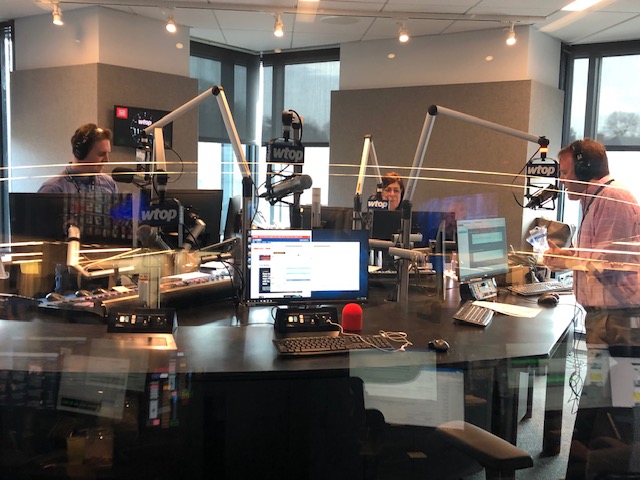
And in the case of commercial radio news and information, outside of time, traffic, weather, and conservative talk, there’s not much there. There are notable exceptions, of course, in commercial radio. Hubbard Radio’s WTOP in Washington, D.C. is one of these – a well-financed news operation with a great strategy and the resources necessary to go toe-to-toe with WAMU – American University’s amazing operation in the nation’s capitol, not to mention the Washington Post. If you’re not bringing it in for news and information in D.C. each and every day, you’ll soon be an also-ran.
If you tell me that podcasting represents an opportunity for commercial radio companies to re-establish themselves in the spoken word game, I’d suggest you look at the history of on-demand audio in this country.
It’s been led by public radio programs, franchises, and hosts – not to mention style and formattics.
That’s not to say that efforts by iHeart, Entercom, and other companies aren’t important and impressive – because they are. But popular podcasts are more congruent with public radio content and their audiences rather than the commercial radio platform. It’s why so many public radio shows – like “Fresh Air,” “Wait, Wait…” and others make such great podcasts. And why we’re now seeing the other trend – great podcasts becoming radio shows.
The competition for morning news podcasts has intensified in just the last couple years. NPR, of course, is right there, but the biggest splash has been made with The New York Times’ “The Daily.” Other networks and news units are following suit in the amped up effort to inform an American public with a growing appetite for news, information, and great journalism.
It takes a major resource commitment – financial, human, and otherwise – to put together a working, effective, and talented newsroom, whether 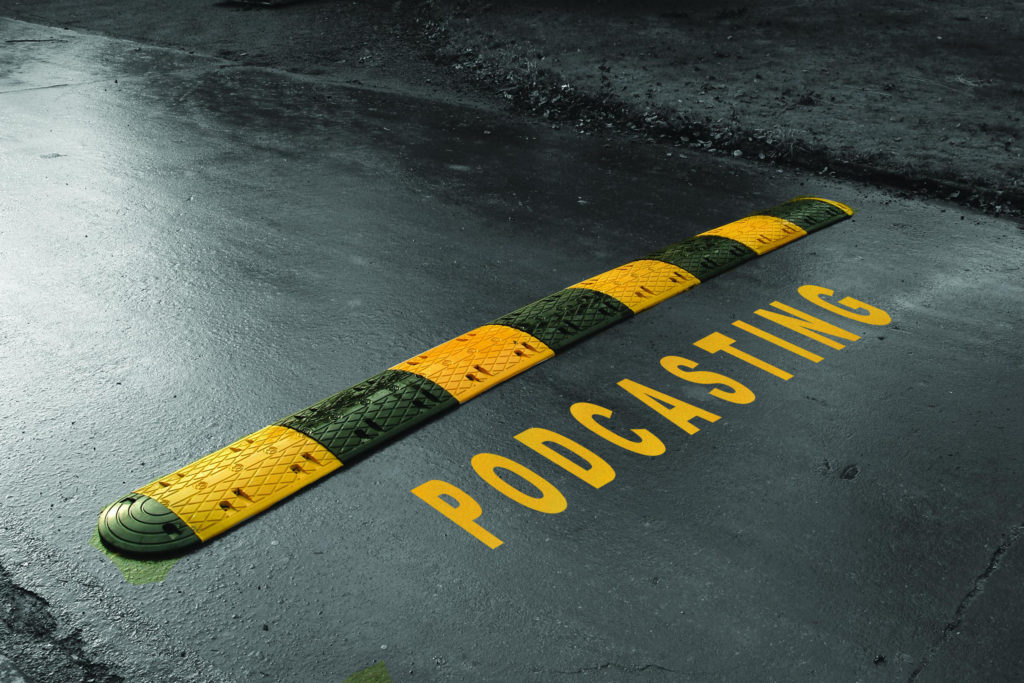 you’re in Pensacola or Philadelphia. Many public radio operations have made that choice, building their facilities, their staffs, and creating consortia like the ones in California and Texas.
you’re in Pensacola or Philadelphia. Many public radio operations have made that choice, building their facilities, their staffs, and creating consortia like the ones in California and Texas.
You can’t fake or “image” news coverage and credibility for long. In the world of journalism, walking the walk is required. You’re either providing a news product for your community or you’re not. And during these highly-charged times when information is at a premium, only those committed to news will have a seat at the table.
I know that some of you reading this in the commercial sector highly resent the degree of public funding (yes, your tax dollars) that partially pay for the content you hear on public radio stations and its associated networks.
That’s largely how it works all over the world, where publicly funded national news operations co-exist nicely with their commercial media cousins. The President’s proposed new budget released just the other day proposes shutting down CPB – the Corporation for Public Broadcasting – public media’s funding arm. And of course, that’s why we have elections – to vote our choices, our opinions, and our beliefs.
This has become a regular occurrence since Trump took office, but this year, the rhetoric has been turbo-charged by the impeachment trial, and Secretary of State Mike Pompeo’s recent dust-up with NPR’s Mary Louise Kelly. As they say, stay tuned.
What kind of news product do we want to have in this country? What are we willing to support, via subscriptions, memberships, and yes, even public radio pledge drives?
It’s never easy to predict the future in a dynamic, rapidly changing environment like media in 2020. New technologies, ownership shifts, and other unforeseen events can change an industry with no warning. And then there’s politics.
But if we put aside our beliefs and biases, and look at the evolution of news media in this country, there’s increasingly less doubt about who will OWN radio news in this uncertain future we’re all facing.
As for “audio news,” that’s the next big question mark, as every journalistic unit, team, entity, and brand are jumping in the pool.
Only the strongest – and most committed – will survive.
- The Exponential Value of Nurturing Radio Superfans - April 28, 2025
- What To Do If Your Radio Station Goes Through A Midlife Crisis - April 25, 2025
- A 2020 Lesson?It Could All Be Gone In A Flash - April 24, 2025




Thanks for sharing this insight. Some of our greatest competition in contests in recent years has come from non-commercial stations. We judge a lot of other state contests and most of the entries are from public stations.
Fortunately we have backing for 100.5 & 790 Newsradio WSGW from our management. We have some novel strategies in place and remain strong. With the decline in print and the quality of TV news shops in our market, we are increasingly getting positive community feedback about the quality of the radio news we provide.
There’s no doubt, Dave, that radio has a big opportunity in smaller markets, especially as other news media has faded. Thanks for the comments.
Thank you for this excellent column, Fred. One note about NPR on SiriusXM: Years ago NPR promised NPR member stations that Morning Edition and All Things Considered would not be available via satellite radio. This move was made to strengthen local station’s ability to keep listener-based revenue going directly to the stations. So far, it has worked.
Ken, I left that little detail out. And you are right – NPR Now does not program either of the network’s incredibly successful news magazines. And they have enough content to fill an entire channel anyway! Thanks for that.
You made a small point, Fred, but one that has grated on me about the evolution of on-demand audio, in particular, the style and feel of pubcasters.
Often I’ll sample a podcast from a non-radio source and hear the softspoken, pointedly enunciated “NPR Speech” of the host and want to scream down the earbuds, “it’s okay to speak normally in your podcast!”
Hey, Eric. Those systemic speech affectations are alive and well throughout radio – whether it’s Top 40 jocks or other formats. But you’re right – many podcasts have that tone, and much of it probably emanates from the influence of Ira Glass and others. Thanks.